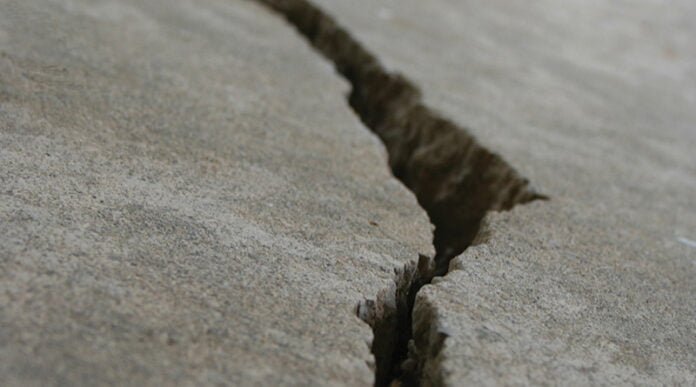Without proper infrastructure, roads and homes built over bentonite have short life spans
Front Range Colorado has seen significant issues with heaving soils under roads and structures. This heaving, caused by the wetting of the bentonite clay soil, can destroy improperly designed and constructed buildings.
I remember riding motorcycles along McCaslin Boulevard years ago just for the roller coaster effect produced by the heaving pavement. Have you driven the section of E-470 just south of the DIA exits, where the road suddenly gets bumpy, or Highway 287 west of Berthoud? Those heaving conditions are caused by bentonite under the roadway. Crews have spent many hours and dollars grinding, repaving and leveling those and other surfaces around the state where this buckling has occurred.
Related: 3 Strategies for Building on Bentonite
A better-dried road base would have been the solution from the start. Unfortunately, trying to keep the ground completely dry is a fool’s errand, as water can come from above or below, and can migrate laterally through the soil until it hits the expansive layer. Once wetted, the bentonite exerts extreme force through the soil and the pavement, causing the roadway to buckle.
Similarly, founding a building on bentonite is fraught with risk. When you read your next soils report, note that the testing of soil samples is typically done at 8,000- 12,000 psf. Typical footer foundations supply 1,000-2,000 psf of load on the ground. It can be surmised that soils that test as expansive when highly loaded would have the capacity to move the comparatively lightly loaded footers.
A lot of problems arose before the risks of building over bentonite were fully known or appreciated. Basement slabs heaved. Foundations cracked and transferred great force into the framed structures above. Remedial repairs can be invasive and expensive, so best to test, and to design for the site conditions.
Related: Selecting Plants for Troubled Soils
Typical solutions to building over bentonite have relied on shaft piers, helical piers or micro piles. These are drilled into “competent bedrock” to a recommended depth that will hold the building in place. Creating void space between the piers, under the foundation wall, protects the assembly from the upward movement of the soil. Getting these values right is critical. So is following the recommendations to the letter. Those recommendations include perimeter drain design and landscaping recommendations, as well as foundation design criteria.
Famous examples of damage caused by bentonite in areas along the Foothills saw homes literally split apart by racking forces from tilted shale. This formation would swell laterally when water was introduced to certain layers containing the dreaded bentonite. In some of these instances, it may have been the pier drilling that created a channel for water to migrate deeper into the shale.
The net result of these issues has been a cavalcade of defect lawsuits, with politicians and attorneys lining up to take advantage.








Hello:
Is there a safe depth of bentonite layer below ground that will not affect building a home above it?
The following is a well log on an adjacent property to the land we are looking at in Montana:
From To Description
0 18 BROWN SANDSTONE
18 35 BROWN GRAY SANDSTONE
35 40 GRAY SANDY BENTONITE
40 55 BROWN GRAY SANDSTONE
55 68 GRAY SAND
68 70 DARK GRAY SHALE & BENT
70 75 DARK GRAY SAND
75 87 GRAY SHALE W/COAL & BENTONITE
87 92 GRAY SILTSTONE W/BENT
92 95 HARD GRAY SAND
95 115 HARD GARY SAND ( PORSITY 46 GPM)
115 125 HARD SAND GRAY COLORED
125 129 GRAY SILTY SHALE
129 133 COAL
133 135 GRAY SHALE W/BENTONITE
Thanks
Cynthia Wolfer